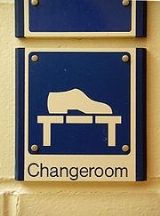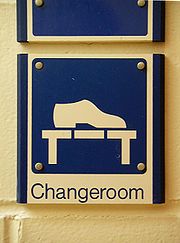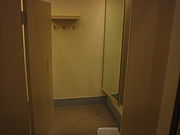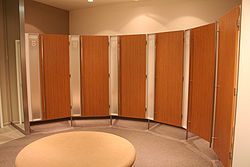
Changeroom
Encyclopedia

A changing room, locker room, dressing room (usually in a sports, theater or staff context) or changeroom (regional use) is a room or area designated for changing one's clothes. Changing rooms are provided in a semi-public situation to enable people to change clothes in privacy
Privacy
Privacy is the ability of an individual or group to seclude themselves or information about themselves and thereby reveal themselves selectively...
, either individually or on a gender basis.
Separate changing rooms may be provided for men and women, or there may be a non-gender specific open space with individual cubicles or stalls. Sometimes a person may change their clothes in a toilet
Toilet
A toilet is a sanitation fixture used primarily for the disposal of human excrement, often found in a small room referred to as a toilet/bathroom/lavatory...
cubicle
Cubicle
Тhe cubicle, cubicle desk, office cubicle or cubicle workstation is a partially enclosed workspace, separated from neighboring workspaces by partitions that are usually tall...
of a washroom
Washroom
A public toilet is a room or small building containing one or more toilets and possibly also urinals which is available for use by the general public, or in a broader meaning of "public", by customers of other...
. Many changerooms include washrooms and shower
Shower
A shower is an area in which one bathes underneath a spray of water.- History :...
s. Sometimes a changing room exists as a small portion of a washroom. For example, the men's and women's washrooms in Toronto's Dundas Square
Dundas Square
Yonge-Dundas Square is a commercial junction and public square, situated at the southeast corner of the intersection of Yonge Street and Dundas Street East in Downtown Toronto...
(which includes a waterplay area) each include a change area which is a blank counter space at the end of a row of sinks. In this case, the facility is primarily a washroom, and its use as a changeroom is minimal, since only a small percentage of users change into bathing suits.
Larger changing rooms are usually found at public beaches, or other bathing areas
Bathing
Bathing is the washing or cleansing of the body in a fluid, usually water or an aqueous solution. It may be practised for personal hygiene, religious ritual or therapeutic purposes or as a recreational activity....
, where most of the space is for changing, and minimal washroom space is included. Beach-style changing rooms are often large open rooms with benches against the walls. Some do not have a roof, providing just the barrier necessary to prevent persons outside from seeing in.
Types of changing rooms
Various types of changing rooms exist.- Locker rooms are usually gender-specific spaces where clothes are changed and stored in lockerLockerLocker may refer to:* Locker , various kinds of storage compartment or container* Footlocker , a storage box* In nautical usage, a "locker" may be a storage place that in other environments would not be referred to as a locker, such as cupboards on board ships for keeping stores, anchor lockers,...
s. They are often used for swimming or other sporting purposes. They are open spaces with no stalls. - Fitting rooms, or dressing rooms, are usually small single-user cubicles where a person may try on clothes. These are often found at retail stores where one would want to try on clothes before purchasing them.
- Green rooms and trap rooms are usually mixed-gender backstage or under-stage changing spaces found at theaters and other similar venues.
Locker rooms
Locker rooms are thus named because they provide lockers for the storage of one's belongings. Alternatively, they may have a locker room attendant who will keep a person's belongings until they come to retrieve them. Locker rooms are usually open spaces where people change together, but there are separate areas, or separate locker rooms, for men and women. Sometimes they are used in swimming complexes.Locking
Lock (device)
A lock is a mechanical or electronic fastening device that is released by a physical object or secret information , or combination of more than one of these....
devices used in locker rooms have traditionally been key or coin lockers, or lockers that are secured with a combination lock
Combination lock
A combination lock is a type of lock in which a sequence of numbers or symbols is used to open the lock. The sequence may be entered using a single rotating dial which interacts with several discs or cams, by using a set of several rotating discs with inscribed numerals which directly interact with...
. Newer locker rooms may be automated, with robotic machines to store clothes, with such features as a fingerprint scanner to enroll and for later retrieval. Locker rooms in some waterparks use a microchip equipped wristband. The same wristband that unlocks the lockers can be used to purchase food and drinks and other items in the waterpark.
Locker rooms are also used in many middle schools and high schools. Most of them include showers for after Physical Education.
Fitting rooms
Fitting rooms, or "dressing rooms", are rooms where people try on clothes, such as in a department store. The rooms are usually individual rooms in which a person tries on clothes to determine fit before making a purchase. People do not always use the fitting rooms to change, as to change implies to remove one set of clothes and put on another. Sometimes a person chooses to try on clothes over their clothes (such as sweaterSweater
A sweater, jumper, pullover, sweatshirt, jersey or guernsey is a garment intended to cover the torso and arms. It is often worn over a shirt, blouse, T-shirt, or other top, but may also be worn alone as a top...
s or coat
Coat (clothing)
A coat is a long garment worn by both men and women, for warmth or fashion. Coats typically have long sleeves and are open down the front, closing by means of buttons, zippers, hook-and-loop fasteners, toggles, a belt, or a combination of some of these...
s), but would still like to do this in private. Thus fitting rooms may be used for changing, or just for fitting without changing.
Rules and conventions
Retail establishments often post rules such as maximum number of items allowed in changing room, e.g. "no more than 4 items allowed in changeroom".Green rooms
A green roomGreen room
In British English and American English show business lexicon, the green room is that space in a theatre, a studio, or a similar venue, which accommodates performers or speakers not yet required on stage...
is a room located backstage in a theatre or some such performance space where the actors (musicians, dancers etc.) wait before they go onstage. Named for its traditional green walls; as green is considered to have a calming effect and is meant to bring focus before the performance and calm nerves. Although this is conventional, they are not always green. Green rooms are usually located backstage, but sometimes under the stage, or to the side. When they are located under the stage, they are often also called "trap rooms" because many stage setups, especially for magicians, involve a trap door that goes to a room under the stage. In a magic trick, a performer may drop down into the trap room, through the trap door, onto a padded surface like a mattress, to "disappear" and change into another outfit. Green rooms are usually not separated by gender, because performers often operate as family
Family
In human context, a family is a group of people affiliated by consanguinity, affinity, or co-residence. In most societies it is the principal institution for the socialization of children...
and help each other change. For example, a husband and wife team of circus performers might need to "rig" each other up with various wiring, cabling, safety harnesses, and the like. Although there are often small gender separated spaces in some green rooms (to meet building codes, etc.), the changing activities of a green room typically spill out into the main area back stage, where there are dressers and stagehands available to assist in the change of outfit.
Cleansing stations
Traditionally, before the advent of modern plumbing, there existed a number of cleansing stations for cleansing one's clothes and body. Cleansing stations were separated by gender, and combined the function of cleaning clothes with cleaning of the body. The closest modern equivalent would be a combination laundromat plus locker room with showers.During the nineteenth, and early part of the twentieth century, the increase of urbanization
Urbanization
Urbanization, urbanisation or urban drift is the physical growth of urban areas as a result of global change. The United Nations projected that half of the world's population would live in urban areas at the end of 2008....
caused an increase in the spread of disease. Poor hygiene was determined to be the cause. Since many families did not have practical means to clean themselves or their clothes, public cleansing stations were established for their use.
Store fitting rooms


Émile Zola
Émile François Zola was a French writer, the most important exemplar of the literary school of naturalism and an important contributor to the development of theatrical naturalism...
noted their existence in his novel Au Bonheur des Dames
Au Bonheur des Dames
Au Bonheur des Dames is the eleventh novel in the Rougon-Macquart series by Émile Zola. It was first serialized in the periodical Gil Blas and published in novel form by Charpentier in 1883....
(1883), and that they were then forbidden to men. Some years later, when Henri Gervex
Henri Gervex
Henri Gervex was a French painter born in Paris, and studied painting under Alexandre Cabanel, Pierre-Nicolas Brisset and Eugène Fromentin....
, who painted Jeanne Paquin
Jeanne Paquin
Jeanne Paquin was a French fashion designer, known for her resolutely modern and innovative designs.Born in Saint-Denis in 1869, Paquin trained as a dressmaker at Rouff and later opened her own fashion house in 1891, the first woman to ever do so...
in 1906, that was no longer the case.
In any case, Buster Keaton
Buster Keaton
Joseph Frank "Buster" Keaton was an American comic actor, filmmaker, producer and writer. He was best known for his silent films, in which his trademark was physical comedy with a consistently stoic, deadpan expression, earning him the nickname "The Great Stone Face".Keaton was recognized as the...
worked in one in an American
United States
The United States of America is a federal constitutional republic comprising fifty states and a federal district...
1928
1928 in film
-Events:Although some movies released in 1928 had sound, most were still silent.* July 28 - Lights of New York is released by Warner Brothers. It is the first "100% Talkie" feature film, in that dialog is spoken throughout the film...
silent
Silent film
A silent film is a film with no synchronized recorded sound, especially with no spoken dialogue. In silent films for entertainment the dialogue is transmitted through muted gestures, pantomime and title cards...
comedy
Comedy
Comedy , as a popular meaning, is any humorous discourse or work generally intended to amuse by creating laughter, especially in television, film, and stand-up comedy. This must be carefully distinguished from its academic definition, namely the comic theatre, whose Western origins are found in...
The Cameraman. Since then, they have continued to provide comic scenes in films, for example in the 1995
1995 in film
-Top grossing films:-Events:* March 22 - The Dogme 95 movement is officially announced in Paris by Danish directors Lars von Trier and Thomas Vinterberg.* March 28 - Actress Julia Roberts and singer Lyle Lovett announce their plans for separation....
French film Les Trois Frères
Les Trois Frères
Les Trois Frères is a 1995 French film, directed by and starring Didier Bourdon and Bernard Campan.The film won the award for best first work at the César Awards in 1996.-Plot:...
.
Changing room security
Because of the privacy afforded by changing rooms, they create a problem in the trade off between security and privacy, wherein it may be possible for crime to be perpetrated by persons using the cover of privacy to sell drugs, or steal clothing from a department store. Some department stores have security cameras in the changing rooms.Communal changing rooms pose less of a risk of theft than fitting rooms, because there is not total privacy. In particular, the perpetrator of a crime would not know whether or not other users might be undercover police or security guards. Many modern changing rooms often have labyrinth
Labyrinth
In Greek mythology, the Labyrinth was an elaborate structure designed and built by the legendary artificer Daedalus for King Minos of Crete at Knossos...
-style entrances that have no door, so that people outside cannot see in, but security can walk in at any time without the sound of an opening door alerting persons inside. Washrooms in which changing clothes is merely a secondary purpose often also have such labyrinth openings. Many washrooms have security cameras in the main area with a view of the sinks and the urinals from a viewing angle that would only show the back of a user. However, when a washroom is located near a fountain, wading pool, or the like, and is likely to be used for changing clothes, some believe that washroom surveillance cameras would be a violation of privacy.
Another security risk present is that of theft. If belongings are left behind, anyone may simply take them, unless they are secured. Lockers exist for this purpose, and operators may post signs waiving responsibility for stolen items.

